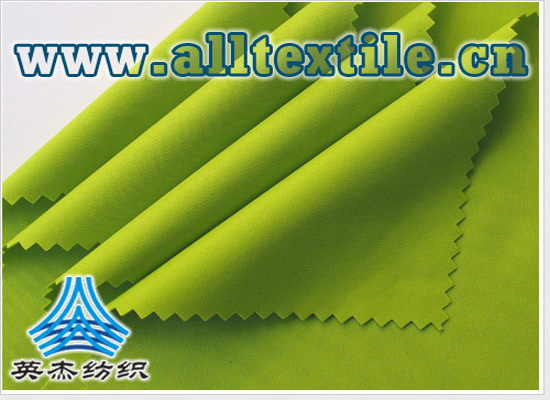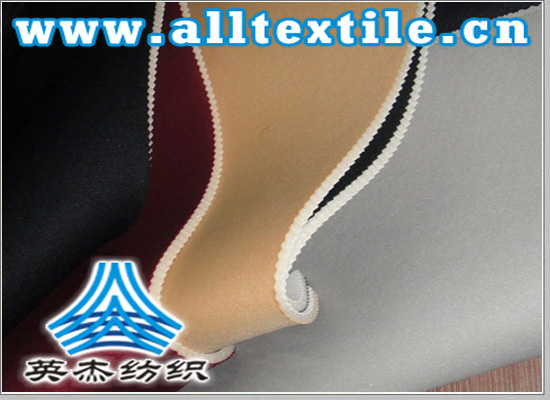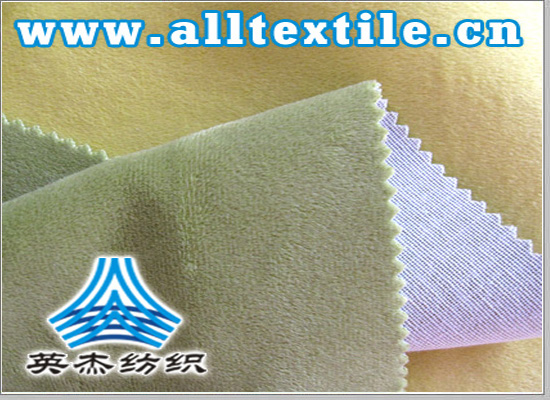Knitted fabricsBasic knowledge
Overview:
We learn about fabrics starting from how to describe them. In principle, our description of knitted fabrics is as follows:
Composition + organization + weight + width + yarn count + number of needles + others (such as color, special process description (AOP, Y/D), etc. )
Example: 100% cotton jersey, 140G/M2, width 180CM, 32S, 24G, all-over printing
The composition, structure and weight describe knitted fabrics Three major elements are indispensable. Of course, the more detailed the fabric description is, the better.
Only in this way, we will have a clearer understanding of the fabric, so that we can better judge the price, performance, etc. of the fabric.
Let’s follow the above sequence to understand some basic knowledge of fabrics step by step.

1. Composition (COMPOSITION)
Most of the fabrics we come into contact with are made of yarn Or threads are woven by looms, while yarns or threads are spun from various fibers
. Therefore, the so-called composition is the percentage of various fibers in the fabric. Below is a detailed list of the various fibers we encounter
(FIBRE). Fibers are mainly divided into short fiber (SPUN) and long fiber/filament (FILAMENT).
1. Plant fiber plant fiber
l Cotton: cotton
l Linen: flax/linen; ramie
l Bamboo Fiber: bamboo fiber
2. Animal fiber animal fiber
l Wool: cashmere/cashmere; mohair; alpaca; rabbit hair/Angora/ camel hair
camelhair
l Silk: tussah silk; mulberrysilk
3. Man-made fiber man-made fiber
l Inorganic fiber: metal fiber; glass fiber glass; gold and silver lurex; carbon fiber carbon
fiber
l Regenerated fiber regeneration fiber: viscose/rayon; cupro Fiber cupra; acetate fiber; rich
strong fiber polynosic; protein fiber (azoncascin; soybean/pea protein, corn
rice fiber corn protein)

l Tencel (Lyocell): the raw material is natural wood pulp, which is an environmentally friendly fiber; MODAL, Lenzing, Austria
(Lenzing) High wet modulus cellulose regenerated fiber developed by the company
4. Synthetic fiber synthetic fiber/chemical fiber
l Polyester (PET/ T): polyester (trademark Terylene/Dacron/Tetron)
l Nylon (PA): polyamide/nylon (trademark Caprolan/Amilan/Tactel)
l Acrylic (PAN): polyacrylic /acrylic (trademark Orlon/Acrilan/Creslan)
l Spandex (PU): polyurethane/spandex/lycra
l Polypropylene (PP): polypropylene Mainly used for underwear, diapers
l PVA: polyvinyl alcohol
l PVC: polyvinyl chloride (trademark Teviron/Rhovy/Dianlun)
l Aramid Fiber: aramid fiber, mainly used in firefighting suits, body armor and other special protective clothing.
Two concepts: blended (mixed) and interlaced (interlace)
Blended yarn—a yarn formed by mixing two or two different fibers together.
Blended fabrics – products woven from blended yarns.
Interwoven fabrics – products woven from yarns of different compositions.
2. STRUCTURE—–refers to the arrangement, combination and connection of loops in the fabric
The concept of knitting: using knitting needles to bend the yarn A method of forming a fabric by looping and intertwining each other.
Its biggest feature is that it is made of coils.
Knitting is divided into weft knitting and warp knitting. Weft knitting is when one or several yarns are fed into the knitting needles in the weft direction; warp knitting is when one or several groups of parallel arranged yarns are wound around the knitting needles in the radial direction.

According to organization, knitted fabrics are mainly divided into the following types:
1. Jersey cloth ( Weft plain knitted fabric) JERSEY
2. Rib RIB: 1X1, 2X2, changing rib, needle rib, transfer rib
3. Mesh PIQUE: four-corner mesh/single pique , hexagonal mesh/double pique; (single-sided tuck fabric)
4. Birdseye fabric BIRDEYE FABRIC
5. Cotton wool fabric INTERLOCK
6. Striped cotton DROPNEEDLE INTERLOCK
7. Terry cloth FRENCHTERRY
8. Velvet VELVET
9. Terry cloth TOWELFABRIC
10. Flannel TERRY WITH BRUSH/FLEECE
11. Polyesterface and cotton back (for reference only)
12. Air layer Ponte-roma/Italianrib (for reference only)
p>
13. Waffle WAFFLE
14. Polar fleece POLAR FLEECE, ultra-fine denier MICROPOLAR FLEECE
15. Composite fabrics, such as knitted GEORGETTE KNITTING GEORGETTE
16. Jacquard fabric JACQUARD: single-sided jacquard and double-sided jacquard
17. Plush FAKE FUR: also called artificial hair
18. Warp knitted mercerized velvet TRICOT
19. Warp knitted mesh NET/MESH
20. �WARP KNITTED VELVET
21. WARP KNITTED CORDUROY
22. WARP KNITTED JACQUARD
23. COMBINED FABRIC: specifically refers to a fabric made by bonding two or more identical or different fabrics. It can be a composite of knitted fabrics and woven fabrics, or a composite of weft knitted fabrics and warp knitted fabrics. .
24. Other special fabrics: such as hanging thread fabrics, etc.
Please check the fabric samples for details.
3. Gram weight (WEIGHT)
Gram weight is divided into several types: square meter weight; Mumi (silk generally uses Mumi to express the gram weight), ounces.
The definition of square meter weight: the weight of fabric per square meter, generally in “grams/square meter”, g/m2
The definition of mmi: fabric width 1 inch, 25 yards long, weight 2/3. The daily currency is 1m/m
1 mm (m/m)=2.5/0.58064=4.3056g/m2
10M/ The square meter weight of M’s silk is 10 Its complete expression is
“oz/square yard”, and its conversion relationship with square meter weight is as follows:
1 ounce/square yard (oz/yd2)=33.9g /m2
The square meter weight of 8OZ denim fabric is 8X33.9=226.4g/m2
Gram weight meter: The principle of the weight meter we usually encounter is very simple. The diameter of the carving knife is 11.3CM. After calculation, we can conclude that the area of the circular fabric we carved is 3.14X (11.3/2) X (11.3/2) = 100cm2, so, The weight of the fabric we get is often calculated by weighing the round fabric and then multiplying it by 100.
According to the definition of gram weight, we can also use small pieces of fabric to weigh and calculate the gram weight of the fabric. For example, we can cut a small piece of fabric
2cmx5cm, If the weighed weight is 0.25g, then the weight of the fabric can be calculated to be 250g/m2. Note that, firstly, the area of a small piece of fabric should be easy to calculate, and secondly, the error in the weight calculated by the scale is relatively large, but it is still an emergency method.
4. Door width (WIDTH)
Door width, also called width, refers to the lateral width of the finished fabric, and there is a difference between the actual door width and the effective door width.
The actual door width includes burrs. The effective door width is a factor that the factory is very concerned about. The size of the effective door width directly affects the unit consumption of clothes
, ultimately affecting the cost of a single piece of clothing. Door width units include centimeters, inches, etc.
Actual door width = effective door width + raw edge width on both sides
5. Yarn count (COUNT)
See the information “Yarn” for details.
Yarns are divided into short fiber yarns (spun yarns), filament yarns (filament yarns) and fancy yarns (fancyyarns).
The following conversion between British branches and denier:
The number of British branches
Common sense: The larger the British count, the thinner the yarn. The smaller the denier, the thinner the yarn. For example, ultra-fine denier means that the yarn is relatively thin.
Misunderstanding: directly draw the equal sign between count and thickness.
The definition of yarn count determines that it is only a measurement relationship between length and weight. Thickness and thinness are relative and there is no inevitable linear relationship.
Because the thickness of the yarn is related to both the spinning process and the raw materials. The thickness of fancy yarn and compact yarn with the same count and the same raw material are completely different, such as 16S slub and 16S compact yarn. Different raw materials with the same count also have different thicknesses, such as 12S acrylic yarn and 12S cotton yarn. Acrylic yarn is relatively fluffy and will appear thicker.
F number: F number often appears in the expression method of chemical fiber, such as “polyester yarn 72D/48F”, which means that the polyester yarn is 72D, and it is
by 48 Yarn spun from 1.5D fiber.
Twist and twist direction: The number of twists of a yarn per unit length is called twist. When the yarn’s fineness is expressed in British counts, its twist is expressed in terms of the number of twists in inches. The twisting of yarn is directional, and there are two types: Z twist and S twist. Generally, most single yarns use Z twist. The twist directions of double-stranded yarns are divided into ZS
twist, ZZ twist, and SS twist. The first one represents the twist direction of single yarn, and the second one represents the twist direction of strands.
AB yarn: A yarn made of two yarns with different twist directions is called AB yarn.
Classification of chemical fiber fineness: 1. Ultrafine fiber; 2. Fine denier fiber; 3. Conventional fiber
Fiber fineness less than 0.3D is called ultrafine fiber; fiber Those with a fineness between 0.4D and 1.0D are called fine denier fibers; those with a fineness higher than 1.0D are regular fibers.
Here are some basic concepts that need to be memorized by rote:
Double yarn
Strands
Blended
Interwoven
Single dyeing
Double dyeing
Combed
Combed
Single branch (S)
Denier (D)
F number
p>
Conversion relationship between yarn counts
Twist
6. Number of needles (GUAGE)
Number of needles GUAGE: refers to the loom (circular Machine) The number of knitting needles arranged per inch on the needle cylinder. The larger the number of needles, the denser the needles, the tighter the cloth surface, and the finer the required yarn.
In knitted fabrics, how to match the yarn count and the number of needles is a big issue. Only by selecting the appropriate yarn count and matching number of needles can fabrics of corresponding weight be
weaved. Since there is too much professional knowledge involved, I cannot explain it clearly, so I won’t go into details here. But
One thing is that the number of stitches in the flat knitting machine is the same as that in the circular knitting machine, so you can ask colleagues in the sweater group for knowledge on the number of stitches.
��, so you can ask colleagues in the sweater group for knowledge about the number of stitches.






